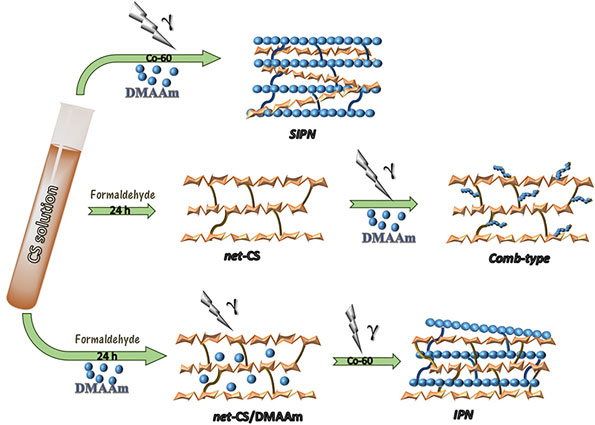Crossref Citations
This article has been cited by the following publications. This list is generated based on data provided by
Crossref.
Sacco, Pasquale
Furlani, Franco
De Marzo, Gaia
Marsich, Eleonora
Paoletti, Sergio
and
Donati, Ivan
2018.
Concepts for Developing Physical Gels of Chitosan and of Chitosan Derivatives.
Gels,
Vol. 4,
Issue. 3,
p.
67.
Patiño, Zaira
Ortega, Alejandra
and
Burillo, Guillermina
2019.
Removal of Cr(VI) ions using a binary grafting of N-vinylcaprolactam and N,N -dimethylacrylamide onto crosslinked chitosan, synthesized by gamma radiation.
Journal of the Mexican Chemical Society,
Vol. 63,
Issue. 4,
Ilić-Stojanović, Snežana
Urošević, Maja
Nikolić, Ljubiša
Petrović, Djordje
Stanojević, Jelena
Najman, Stevo
and
Nikolić, Vesna
2020.
Intelligent Poly(N-Isopropylmethacrylamide) Hydrogels: Synthesis, Structure Characterization, Stimuli-Responsive Swelling Properties, and Their Radiation Decomposition.
Polymers,
Vol. 12,
Issue. 5,
p.
1112.
Ortega, Alejandra
Sánchez, Abigail
and
Burillo, Guillermina
2021.
Binary Graft of Poly(N-vinylcaprolactam) and Poly(acrylic acid) onto Chitosan Hydrogels Using Ionizing Radiation for the Retention and Controlled Release of Therapeutic Compounds.
Polymers,
Vol. 13,
Issue. 16,
p.
2641.
do Nascimento, Diego M.
Nunes, Yana L.
de Almeida, Jéssica S.
Leitão, Renato Carrhá
Feitosa, Judith P. A.
Dufresne, Alain
and
Rosa, Morsyleide de Freitas
2021.
Development of an integrated process to produce CNFs and lignin and its potential applications for agrochemical delivery.
Cellulose,
Vol. 28,
Issue. 17,
p.
10891.
Valencia-May, E.G.
Rivera, E.
Novelo-Peralta, O.
and
Burillo, G.
2022.
Comparative analysis of two hydrogel architectures synthesized by gamma radiation based on dimethylacrylamide and acrylic acid grafted on polyethylene.
Radiation Physics and Chemistry,
Vol. 194,
Issue. ,
p.
109975.
Cruz-Gómez, Angélica
Pérez-Calixto, Mitzi
Velazco-Medel, Marlene A.
and
Burillo, Guillermina
2022.
Antifouling IPNs made of poly(ethylene glycol)/poly(N-isopropyl acrylamide) using gamma radiation.
MRS Communications,
Vol. 12,
Issue. 2,
p.
272.
Ahmed, Md. Shahriar
Islam, Mobinul
Hasan, Md. Kamrul
and
Nam, Kyung-Wan
2024.
A Comprehensive Review of Radiation-Induced Hydrogels: Synthesis, Properties, and Multidimensional Applications.
Gels,
Vol. 10,
Issue. 6,
p.
381.
More, Aarti P.
and
Chapekar, Shubham
2024.
Irradiation assisted synthesis of hydrogel: A Review.
Polymer Bulletin,
Vol. 81,
Issue. 7,
p.
5839.
Castro, Esteban
Ortega, Alejandra
Pérez‐Calixto, Mitzi
Vázquez‐Victorio, Genaro
and
Burillo, Guillermina
2025.
Radiation Grafting of Two PEG Derivatives onto PET: A Comparative Study for Biomedical Applications.
Macromolecular Materials and Engineering,



